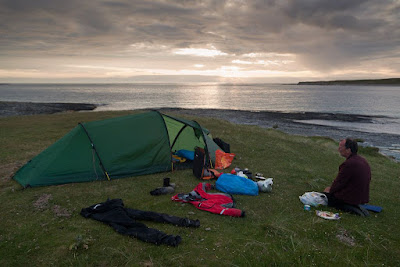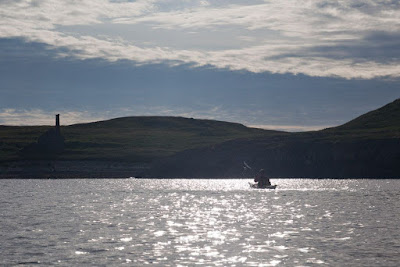We enjoyed the view as the low sun's warm light illuminated the north shore of Islay, all the way to Rubha Bholsa, round which we had recently come. As the sun set, the temperature began to drop so we decided to make our way back down to the beach and light a fire. No sooner had I started descending the steep dune than I experienced a severe pain in my knee and my leg buckled under me. I broke out into a cold sweat. It was exactly a year since
my accident on Gunna, while descending
a similar steep sand dune. The painful events of my last year then all came flooding back, the slow recovery from the accident, the death of my father,
the death of my good friend Jim, who had helped me back from Gunna, the inevitable major surgery on my knee and the hard months of rehabilitation afterwards. But despite all these setbacks, I was here and life felt really good. I paused for a little while more, then I felt a hand on my elbow, it was Phil. He helped me down to the shore.
Phil had found a large wooden pallet at the far end of the beach and dragged and carried it all the way back. We lit it with some smaller sticks I found nearby.
We soon had a warming blaze going and we toasted the memory of those we could no longer share our lives with. We felt so lucky to be alive and able to be here in this wonderful spot.
I planned to write an article of our trip for
Ocean Paddler magazine (
published in issue #25). I had this photo in my mind's eye, with the smoke drifting towards the kayaks. Phil helped me back up the dune,s then he went down again to sit by the fire but the wind kept changing direction. Phil patiently carried both kayaks, backwards and forward along the beach several times, till I got this photo. Ocean Paddler used it as a double page spread and I hope you think Phil's efforts were worthwhile. Thank you Phil! He then helped me back down to the fire.
As the smoke drifted this way and that, we chatted long into the summer night about places we had been to, places we wanted to go to and about those who had been with us. Suddenly a lump came my throat and tear caught my eye. Maybe it was the smoke, maybe it was for those we have lost...





































